


Join thousands of fellow campervan travellers
Sign up for our Britz newsletter to receive inspirational travel content and awesome deals, and we'll send you a copy of our Ultimate RV guide!
Thanks
Please confirm subscription in your email.
The best time to visit National Parks in Western Australia
What you should know about staying in WA National Parks
National Park Passes
Where you can camp
Respecting the environment, First Nations People and culture
The Best Western Australia National Parks to Visit
Purnululu National Park
Windjana National Park
Geike Gorge
Tunnel Creek National Park
Kalbarri National Park
Ningaloo Marine Park
Cape Range National Park
Francois Peron National Park - Shark Bay World Heritage Area
Nambung National Park
Leeuwin Naturalise National Park
Walpole Nornalup National Park
Fitzgerald National Park
Cape Le Grand National Park
The best time to visit National Parks in Western Australia
Western Australia is the largest state in the country, so it’s no surprise that within it there are different climates to enjoy.
Some areas like Perth are famous for having an unbeatable number of sunny days a year, coupled with comfortable temperatures throughout, making it a great place for outdoor adventurers year-round.
Travelling a little further north, you will come across areas like Broome which experience both dry and wet weather, often described as being more tropical and therefore beautifully diverse in its scenery and landmarks.
You can visit WA national parks any time of year and find somewhere sunny, you just need to decide how warm you like it!

What you should know about staying at Western Australia's National Parks
One of the incredible and unique things about Western Australia national parks is how diverse they are. With different landscapes and weather conditions, one of the key things you should do is prepare in advance for the areas you are visiting as things can change very quickly.
Here are some things to consider:
- Changing weather conditions... Some national parks in WA experience tropical rainstorms, while others can reach very hot temperatures you may not be prepared for. It’s a good idea to research the area and check the forecast in advance to make sure you have everything you need in your motorhome such as rain jackets or a decent water supply. Sometimes parks also need to close at short notice for the safety of visitors so make sure you check the government alerts before you travel.
- Isolated areas... The large beautiful landscape of Western Australia means you have plenty of space to take it all in peacefully, but it’s also worth ensuring you have sufficient maps on hand should you get a bit off track, and the right vehicle for the road. We off 4WD vehicle rentals to get to more remote destinations. You can download maps to use offline if you prefer not to use the old paper kind! Remember to look closely at the roads you will travel as there are remote areas that do not have petrol and supplies. You may also like to create a travel itinerary so that you can pre-book all your motorhome camping spots.

National park passes
When travelling to WA National Parks you can either choose to pay for the day with standard park entry fees, or you can buy a park pass. You can use this national park pass Australia wide!
There are different types of passes which vary from 4 week passes for $60 through to annual passes for $120, which are great for those travelling in a motorhome and wanting to visit multiple locations.
The passes cover private vehicles for up to 12 passengers and can be purchased both online, at Parks and Wildlife Service offices, and selected visitor centres.
Where you can camp
To protect the National Parks in Western Australia, there are some areas that do not permit camping, and there are also some that close through the wet season.
It’s a good idea to search the different campgrounds available, and ensure your chosen site has the facilities you need, whether that is power for your motorhome or a water supply.
Make sure to check the rules for each camping ground too, as some areas have a high fire risk and don’t allow things like BBQ’s to be used.
Respecting the environment, First Nations People and culture
Aboriginal Australians have a deep reverence for the land and many sites or rocks carry religious or spiritual significance in Indigenous cultures. As you travel in Australia’s national parks, we encourage you to take time to learn about and honour the traditional owners of Australia’s national parks.
Always respect and follow signs and park rules about where you can stay, and leave no trace of your visit, ensuring to take all rubbish and waste with you. Do not remove plant cuttings, rocks or artefacts from within Western Australia’s national parks. You can find the full list of WA’s list of National Park Authority Regulations online.

The Best Western Australia National Parks To Visit
Purnululu National Park
The Bungle Bungle range in the World Heritage Listed Purnululu National Park is one of Western Australia's most fascinating landmarks and the ultimate place for outback adventure.
Here you can camp out under the stars in your motorhome, four-wheel-drive across rugged terrain and hike through gorges millions of years old. The area in the East Kimberley region also has great Indigenous cultural significance which dates back 20,000 years. Djaru and Gija Aboriginal people are the original inhabitants and caretakers of Purnululu National Park.
From the air, the Bungle Bungle range is an awesome site, rising 300 metres out of the plain. The orange and black stripes of these massive sandstone structures are breathtaking and are best seen from above in a scenic flight.
As you sweep over the range, a hidden world of gorges and pools is revealed with fan palms clinging to walls and crevices in the rocks.
The park covers nearly 240,000 hectares. Despite being made of soft sandstone the range has survived for more than 350 million years. Tours, including scenic flights, are available from Kununurra and Broome.
Camping in Western Australia's natural areas is a special experience. Selected campgrounds from across the state are now bookable online.
Experience and see for yourself as part of the following self-drive itineraries:
- Gibb River Road
- Kimberley Wildnerness Highway: Broome to Kununurra
- West Kimberley Coast and Gorges: Broome, Derby and Fitzroy Crossing
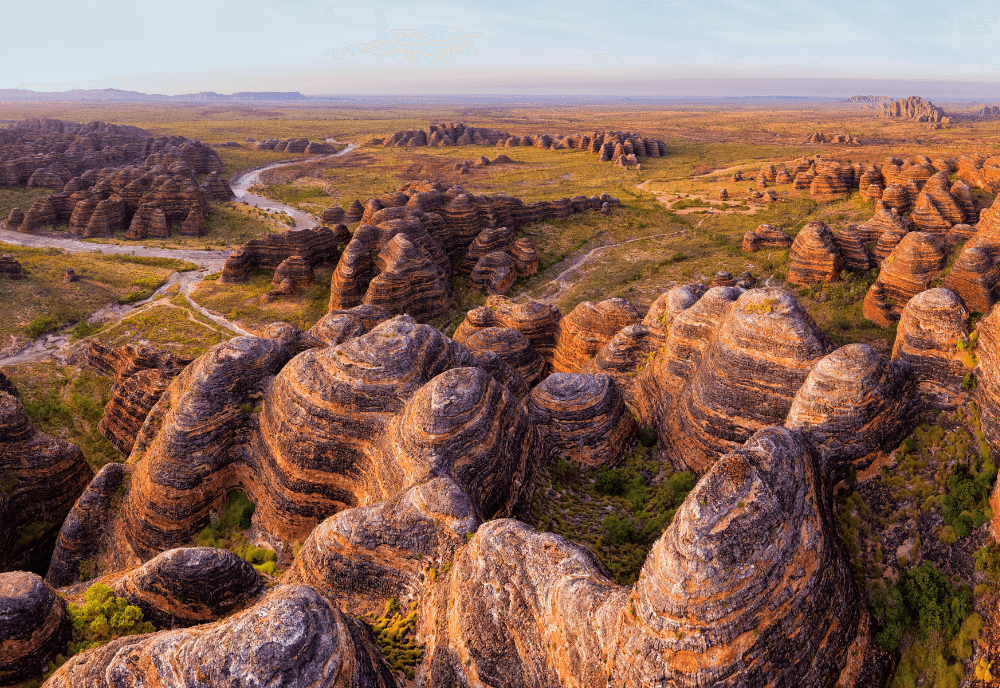
Windjana National Park
Windjana Gorge National Park in the Kimberley region offers stunning bushwalking through the outback wilderness. Rated as one of the most beautiful of all the gorges in this frontier region, Windjana is rich in vegetation and wildlife.
The walls of Windjana Gorge rise up from floodplain of Lennard River, reaching 100 metres high in places. It’s deemed a site of great cultural importance to the local Bunuba people.
After a long day driving, take a dip in refreshing permanent water holes and feel the power of Mother Nature which carved out the gorge over hundreds of millions of years.
A three and a half kilometre easy walking trail winds through the gorge – you’ll see primaeval life-forms fossilised within the gorge walls. Keep an eye out for birds, fruit bats and freshwater crocodiles.
Windjana Gorge National Park is about a two-hour drive from Derby and is best visited during the mild weather conditions between May and September.
Camping in Western Australia's natural areas is a special experience. Selected campgrounds from across the state are now bookable online.
Experience and see for yourself as part of the following self-drive itineraries
- Gibb River Road
- West Kimberley Coast and Gorges: Broome, Derby and Fitzroy Crossing
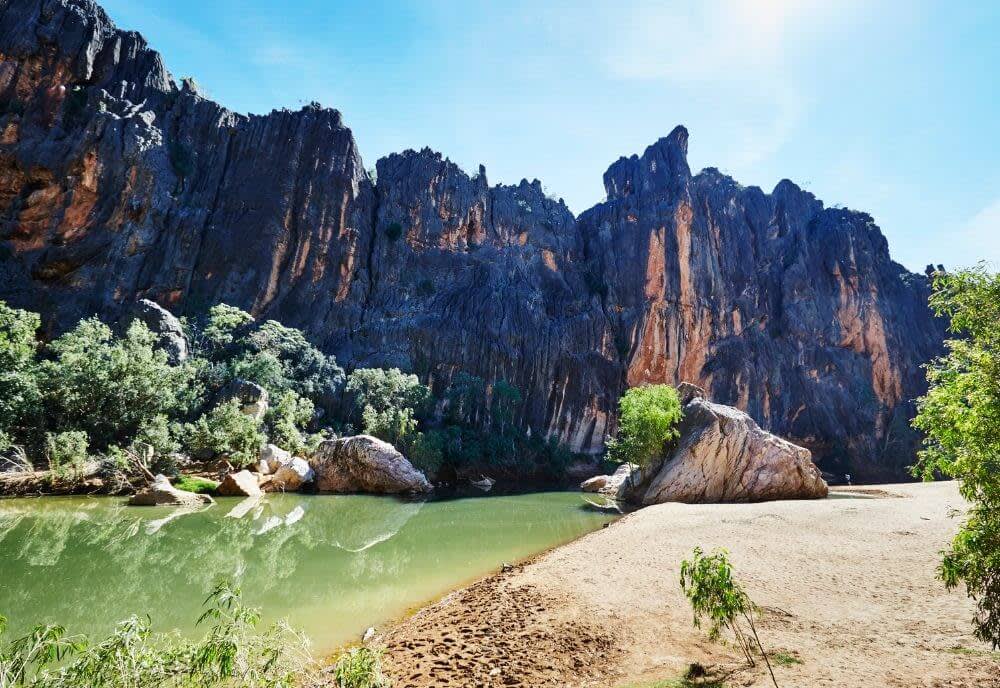
Geikie Gorge
See freshwater crocodiles, all manner of birdlife, and other native animals like dingos and wallabies at Geikie Gorge National Park in the Kimberley region.
The main attraction is the multi-coloured cliffs of Geikie Gorge where the Fitzroy River has cut through fossil reef over millions of years.
You can take a cruise along the river to see the gorge and wildlife up close – and learn about Aboriginal Dreamtime stories of the area. Geikie Gorge is an important Aboriginal cultural area and is known by the Bunaba people as Darngku.
The national park covers more than 3,000 hectares of land and is also home to a riverine forest of river red gum trees and paper barks. Some areas are covered with wild passionfruit vine. Pack a picnic and enjoy the tranquillity of the wilderness, or go bushwalking along two dedicated trails.
The best time to visit the park is from May to October when the weather is mild. You can get to Geikie Gorge National Park by driving about 20 minutes from the town of Fitzroy Crossing. Head there for a day trip as overnight camping isn’t allowed here.
Experience and see for yourself as part of the following self-drive itineraries
- Gibb River Road
- Kimberley Wilderness Highway: Broome to Kununurra
- West Kimberley Coast and Gorges: Broome, Derby and Fitzroy Crossing
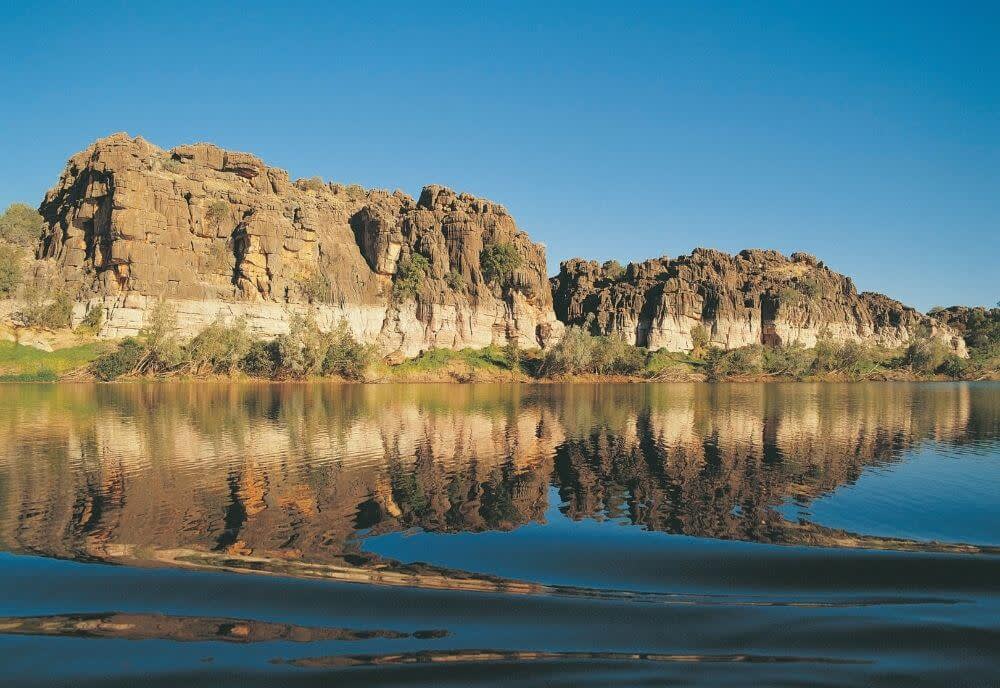
Dimalurru (Tunnel Creek) National Park
A visit to Dimalurru (Tunnel Creek) National Park is a truly unique experience that you must include on your Kimberley itinerary. It is close to Windjana Gorge, allowing you to see both landmarks in one day.
Dimalurru contains Western Australia’s oldest cave system. Walk through the 750-metre tunnel which takes you from one side of the Napier Range to the other. Keep your eye out for the many bats, fish and freshwater crocodiles that live in the cave. As a site of significance to the local Bunuba people, we reckon it’s best to visit the site with a local guide and learn about the spiritual significance of the area.
The tunnel is the oldest cave system in Western Australia. You will get to see little waterfalls coming over the ledges on the sides, and huge stalactites dangling from the ceilings. It is not far off the beaten track, and you don’t need a four-wheel drive to get there, but you do need a torch!
The Dimalurr (Tunnel Creek) National Park is halfway between Derby and Fitzroy Crossing. Allow at least two hours to get there from either direction. Flights run between Perth and Broome, Derby or Kununurra.
Drive yourself or join one of the many fantastic overland tour groups visiting the area. Entry is restricted during the wet season.
Experience and see for yourself as part of the following self-drive itineraries
- Gibb River Road
- West Kimberley Coast and Gorges: Broome, Derby and Fitzroy Crossing
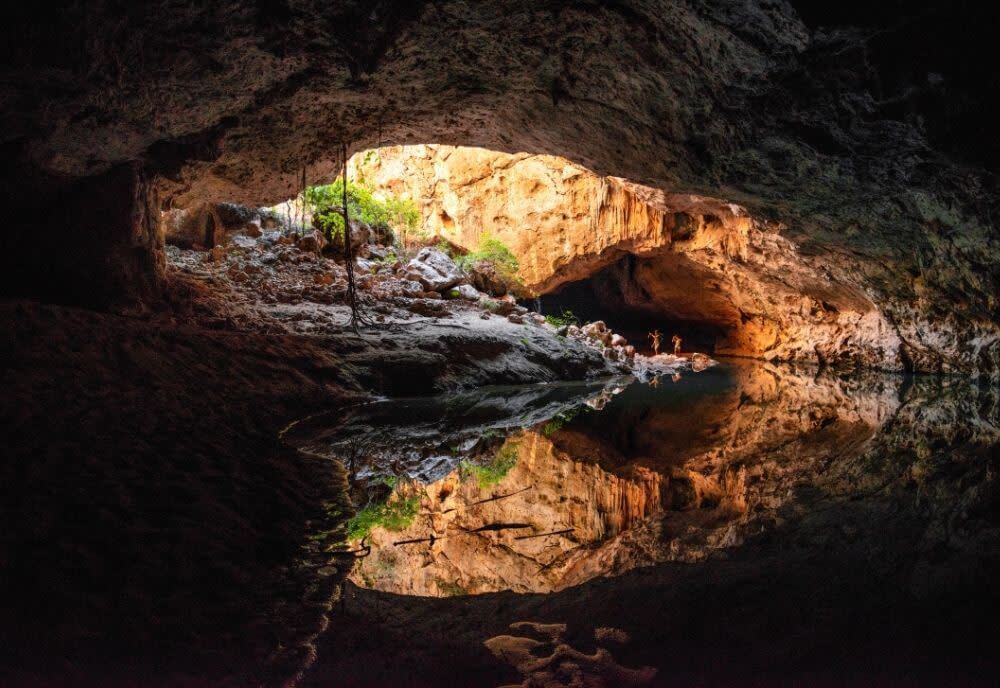
Kalbarri National Park
Over 183,000 hectares of outback adventures, dramatic gorges and dazzling wildflowers make Kalbarri National Park one of Western Australia's most popular places to visit.
The seaside town of Kalbarri is a six and a half-hour drive north of Perth. You'll also find Kalbarri National Park on the itineraries of many tours departing from Perth.
Go bushwalking, gorge hiking or canoeing and take a journey back 400 million years, when the tidal flats of an ancient sea formed the striking red sandstone and the mighty Murchison River carved out deep gorges on its way to the ocean.
For a more relaxed and equally breathtaking experience, drive out to the park's many lookouts for some must-snap vistas, including the famous Nature's Window, The Loop, Z Bend, Hawkes Head and Ross Graham, Red Bluff and Pot Alley.
To see the park ablaze with the colours of spring, visit between July and October. Over 1,100 varieties of wildflowers are found here, from Grevilleas to feather flowers.
You're also likely to encounter an abundance of birdlife and, although most native mammals are nocturnal, you can sometimes see kangaroos and emus during the day.
Experience and see for yourself as part of the following self-drive itineraries:
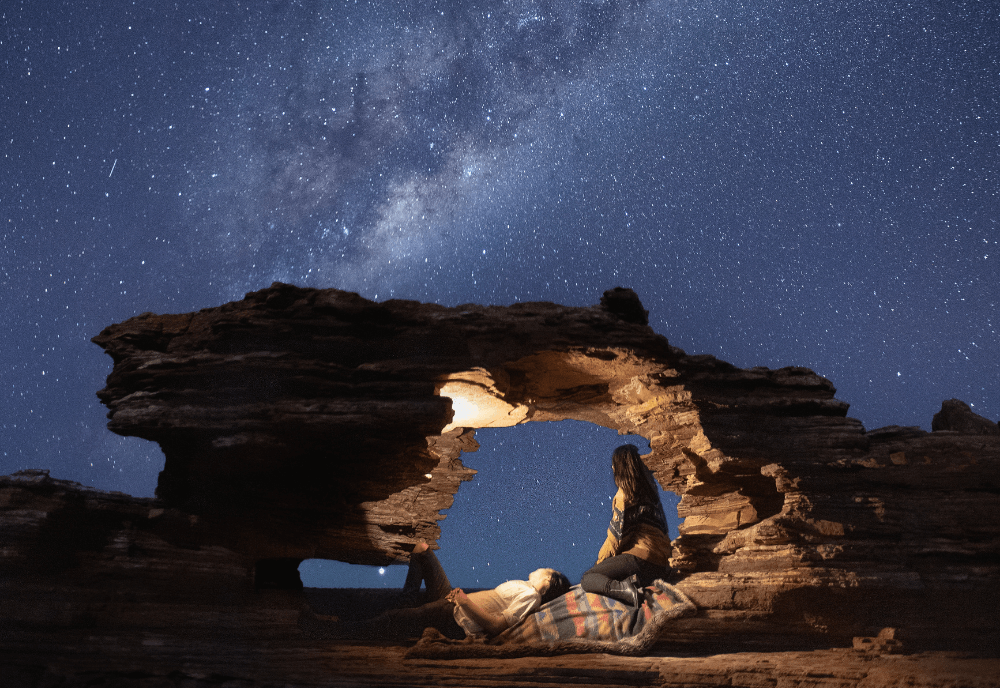
Ningaloo Marine Park
UNESCO World Heritage-listed Ningaloo Marine Park is where you'll find the world's largest fringing reef, the Ningaloo Reef - 300 kilometres of biodiversity reaching from Red Bluff to Exmouth, and just a short swim from the shore in many places. While not technically a national park, you won’t want to miss it. To get there, take a two-day drive from Perth to Coral Bay or Exmouth, or join an extended guided tour.
Slip-on a snorkel or jump aboard a diving tour for face-to-fin encounters with some 500 species of fish, manta rays and turtles, as you glide over 200 varieties of coral. If you'd prefer to stay dry, glass-bottom boat tours offer a window to this underwater world.
Just beyond the reef lies one of the best places on Earth for a swim with the largest fish in the ocean, the gentle whale shark. They're regular visitors between March and late July, and from June to November, you can watch the humpback whales make their annual migration too.
Not surprisingly, the fishing is top-notch too, with tuna, marlin and sailfish the prized catches. Fish the designated beach zones or join a fishing charter.
Experience and see for yourself as part of the following self-drive itineraries:
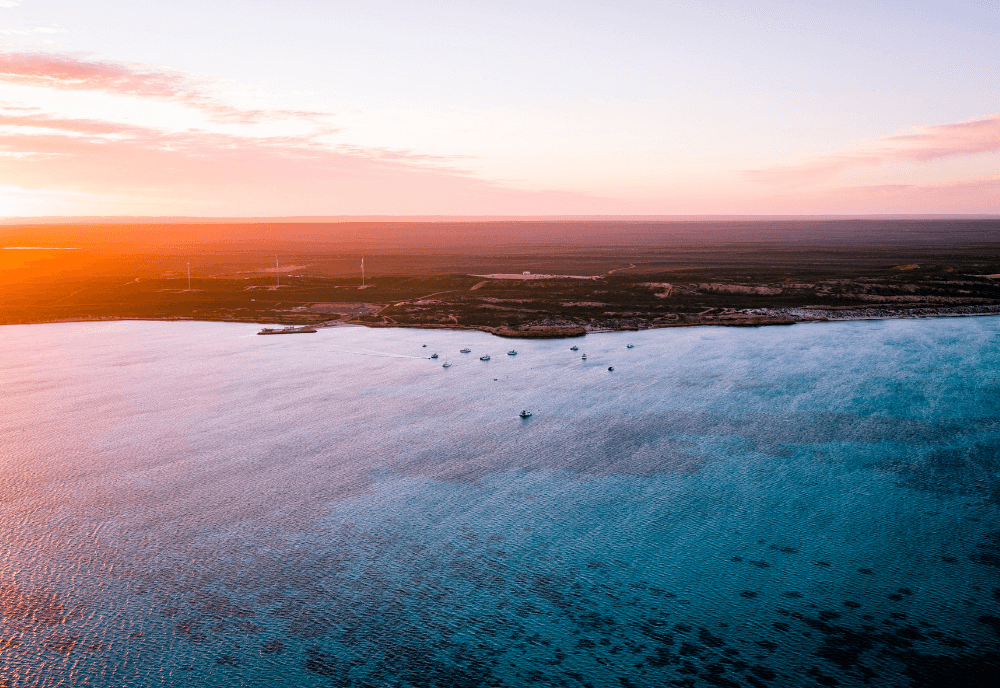
Cape Range National Park
Pristine Cape Range National Park near the town of Exmouth offers some amazing outback adventures from four-wheel driving to gorge hiking and bushwalking - and what's more, it adjoins a stunning coastline where you can go swimming and snorkelling.
The area is known for the striking contrast of turquoise waters and sandy beaches of Ningaloo Marine Park, and the rugged scenery of Cape Range.
Some of the park's more famous attractions include Shothole and Charles Knife canyons, Yardie Creek, Mangrove Bay (bird hide), Mandu Mandu Gorge, Turquoise Bay and the many pristine beaches and amazing coral snorkel sites.
Cape Range National Park is a half an hour drive from Exmouth. Shuttle bus services to Turquoise Bay and Yardie Creek are available.
Experience and see for yourself as part of the following self-drive itineraries:
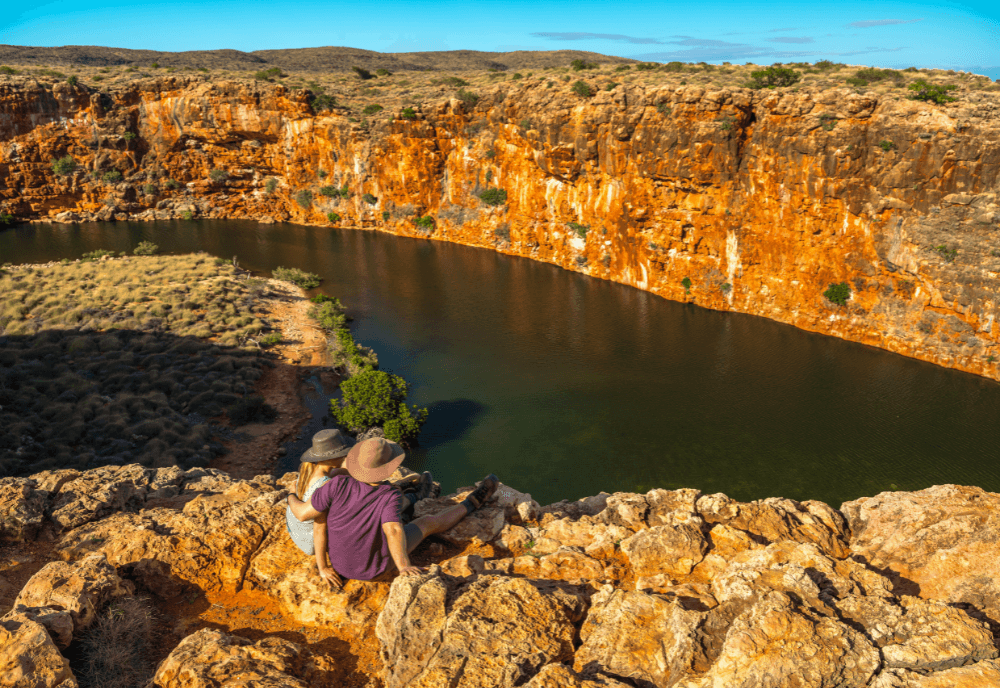
Francois Peron National Park - Shark Bay World Heritage Area
For a four-wheel driving adventure along a scenic coastline with dramatic red cliffs and white sandy beaches, head to Francois Peron National Park in the Shark Bay World Heritage Area.
Once a sheep station, the park is now one of the most important wilderness areas in Australia and is home to many rare and endangered species.
From the cliff tops of Cape Peron you can see dugong, manta rays, turtles and sharks swimming in the water below.
The Peron homestead precinct, just six kilometres off the Monkey Mia Road, has a visitor centre, a self-guided station walk trail, picnic facilities and even a hot tub where you can soak in artesian water.
There are plenty of outback camping facilities at Big Lagoon, Bottle Bay, Herald Bight and Gregories Francois Peron National Park is a 10-minute drive from Denham.
Camping in Western Australia's natural areas is a special experience. Selected campgrounds from across the state are now bookable online.
Experience and see for yourself as part of the following self-drive itineraries:
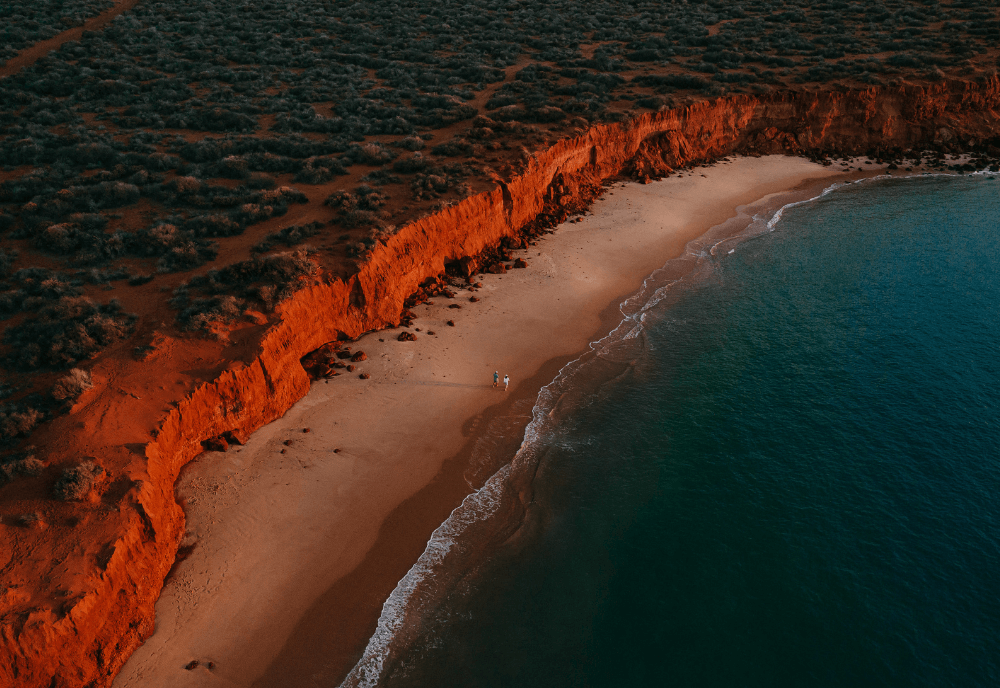
Nambung National Park
Home to the famous Pinnacles Desert about a three-hour drive north of Perth, Nambung National Park is one of Western Australia's most unique natural attractions.
Here, thousands of huge limestone pillars rise from the shifting yellow sands and look more like something from a science fiction movie. You can get up close to the Pinnacles on a scenic drive and walk trail that includes an amazing lookout over the park.
It's believed the Pinnacles were created millions of years ago as seashells were broken down into sand and then eroded by water and wind.
Nambung National Park also features secluded white sandy beaches perfect for swimming and snorkelling. Hangover Bay is one the best known with picnic tables, gas barbecues and a boat launch.
The windsurfing and surfing is top-notch - and you might even see a bottlenose dolphin or sea lion swimming offshore. From August to October, the vegetation at Nambung National Park springs to life with colourful wildflowers.
The park is easy to access by camper or you can take a coach or four-wheel drive tour to the Pinnacles from Perth.
Experience and see for yourself as part of the following self-drive itineraries:
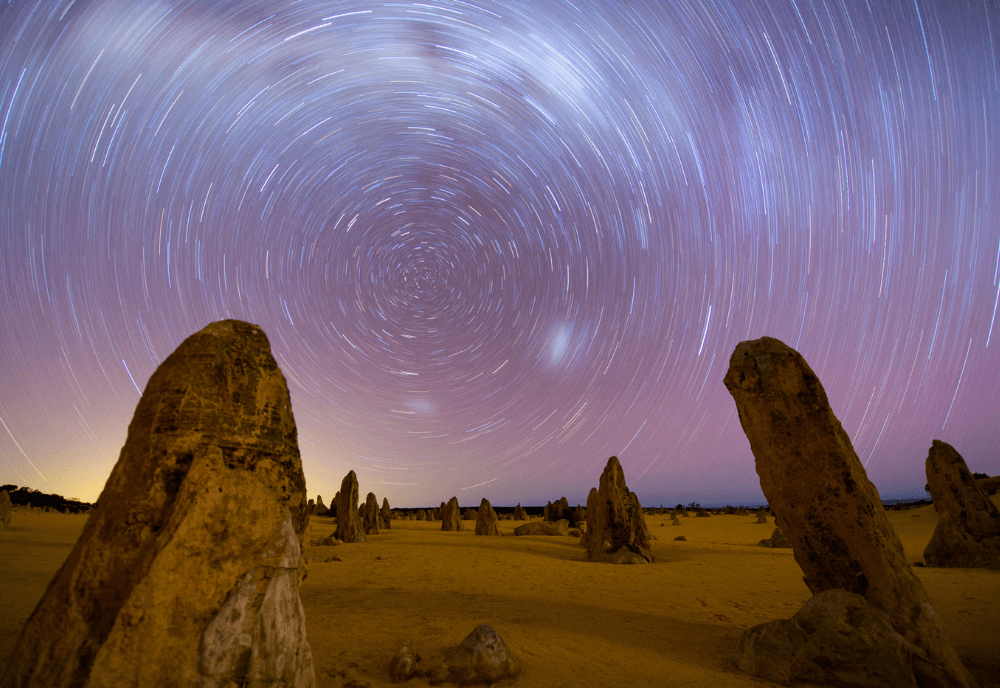
Leeuwin Naturaliste National Park
Rugged sea cliffs and windswept headlands meet the ocean in dramatic fashion at Cape Leeuwin, in the Leeuwin-Naturalist National Park in the southwest of the State.
Cape Leeuwin is the most south-westerly tip of Australia and one of the best places to whale watch. Here the Indian and Southern Oceans meet, in summer the cape sparkles in the sunshine while in winter fierce ocean swells crash against land.
The Leeuwin-Naturalist National Park's home to historic Cape Leeuwin Lighthouse which acts as a maritime landscape and important meteorological site - guided tours are available.
Cape Leeuwin is the starting point for the Cape to Cape Track which stretches 120 kilometres to Cape Naturaliste in the north. The bushwalking track journeys through the national park taking in forests of karri trees and beaches.
There are many scenic lookouts along the way where you can see humpback, southern right and rare blue whales offshore.
For the best swimming head to the protected beaches at Hamelin Bay, Foul Bay and Cosy Corner. Leeuwin-Naturaliste National Park Leeuwin is about a four-hour drive south of Perth. Camping in Western Australia's natural areas is a special experience, campgrounds are bookable online.
Experience and see for yourself as part of the following self-drive itineraries:
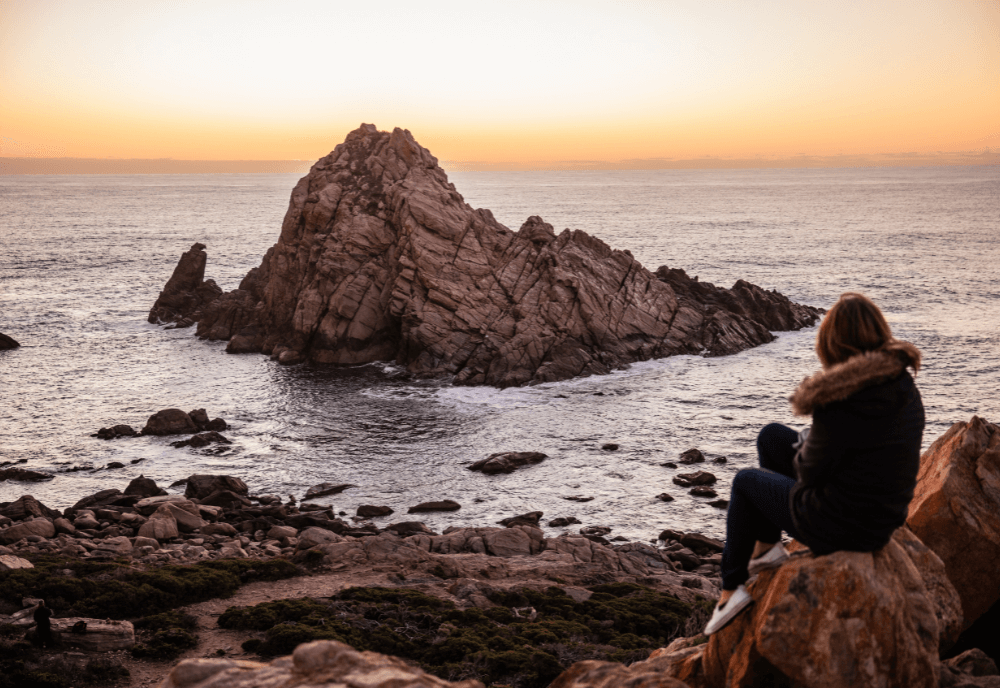
Walpole Nornalup National Park
See giant red tingle trees at Walpole-Nornalup National Park in the south of Western Australia. These towering old-growth forests are part of the Walpole Wilderness area and have remained virtually untouched.
To get up close to these pristine forest beauties visit the Valley of the Giants and Tree Top Walk to the east of Walpole. You can get a magnificent view of the forest canopy from the Tree Top Walk, while the Valley of the Giants leads you to giant red tingle trees with trunks up to 20 metres in circumference.
Walpole-Nornalup National Park is also home to a rugged coastline, peaceful inlets, rivers and forests of karri trees. In the southwest of the park, about 5,000 hectares of near-pristine bushland has been set aside for bushwalkers. The famous Bibbulmun Track passes through the Walpole-Nornalup National Park on its 1,000-kilometre route from the Perth hills to Albany.
If you’re visiting between February and April there’s also the chance to see the annual migration and spawning run of the Australian salmon.
There are campsites dotted throughout the park. The park surrounds the towns of Walpole, Nornalup and Peaceful Bay, a five-hour drive south of Perth.
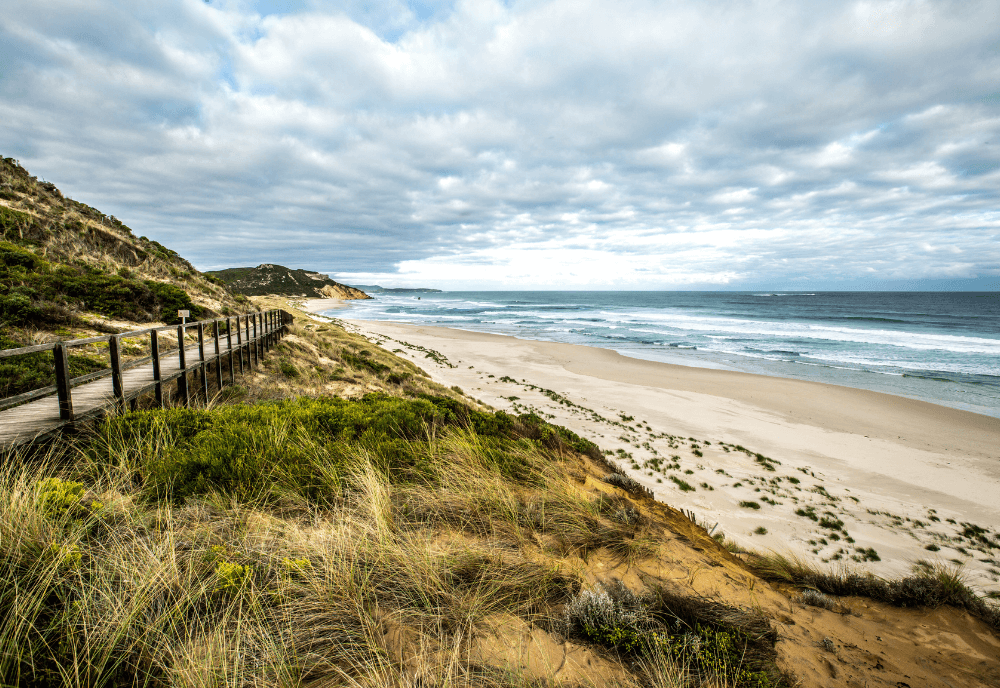
Fitzgerald River National Park
The pristine wilderness of Fitzgerald River National Park on the southern coast is perfect for anyone with a love of nature and a thirst for adventure. Here you can go bushwalking, camping, canoeing, fishing and whale watching.
It’s now recognised as one of the most diverse botanical regions on earth with around 1,800 species of flowering plants alone. In spring, the landscape is dotted with colourful wildflowers including banksias, hakeas, bottlebrush, feather flowers, Quaalup bell and many others.
Go bushwalking and you might spot endangered native animals like the dibbler, a small marsupial that has recently been rediscovered in the park.
Fitzgerald River National Park is made up of coastal hills collectively known as the Barrens, as well as interesting spongelike cliffs. These cliffs are made of soft rock formed millions of years ago and featuring the fossils of sea sponges. From the cliffs of Point Ann, you can see southern right and humpback whales migrating along the coast in winter.
Fitzgerald River National Park is about a two-hour drive northeast of Albany. Camping in Western Australia's natural areas is a special experience.
Experience and see for yourself as part of the following self-drive itineraries:
- Great Southern Wine Trail: Albany, Denmark and Mount Barker
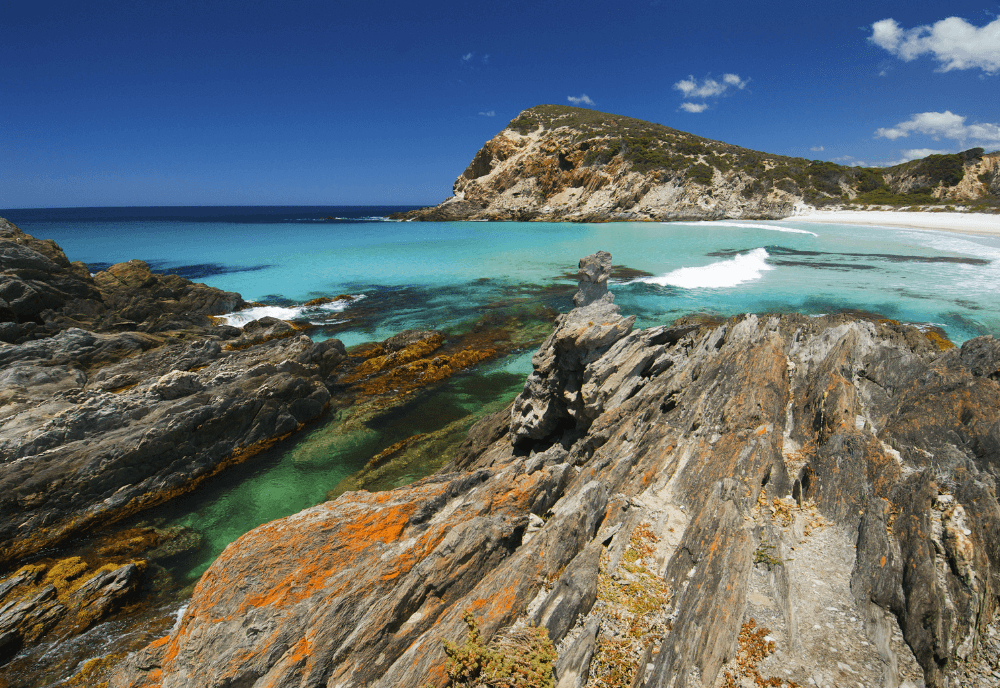
Cape Le Grand National Park
There aren’t too many places in Australia where kangaroos sunbake on the beach, but at Cape Le Grand National Park this is just one of the many natural highs on offer.
This pristine park near Esperance is known for its stunning scenery and idyllic beaches where you can go swimming, bushwalking, fishing and camping. The landscape changes from massive granite outcrops to freshwater pools and unbelievably white sandy beaches with views over many islands.
Lucky Bay is home to a colony of friendly kangaroos which are often seen soaking up the sun. It also offers a great campsite and picnic area. With beachside views and a tranquil atmosphere, this is camping at its best.
There are many excellent bushwalking trails through the park which traverse the rugged coast and beaches – enjoy the views and then stop off for a refreshing dip in the ocean.
Rock-climbing is popular at Frenchman’s Peak and Mount Le Grand. In spring Cape Le Grand National Park bursts into colour as wildflowers bloom, including groves of banksia.
You can reach Cape Le Grand National Park by campervan in about half an hour from Esperance. Day tours operate in the park.
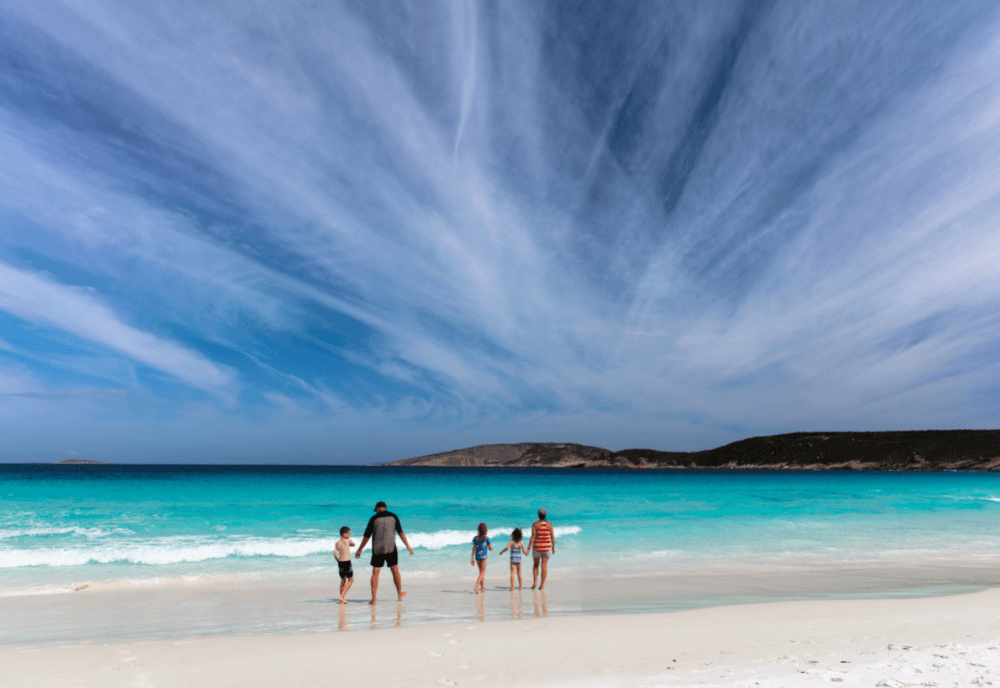
If you want to continue your National Parks adventure around the country, check out more of our favourite Aussie National Parks.
